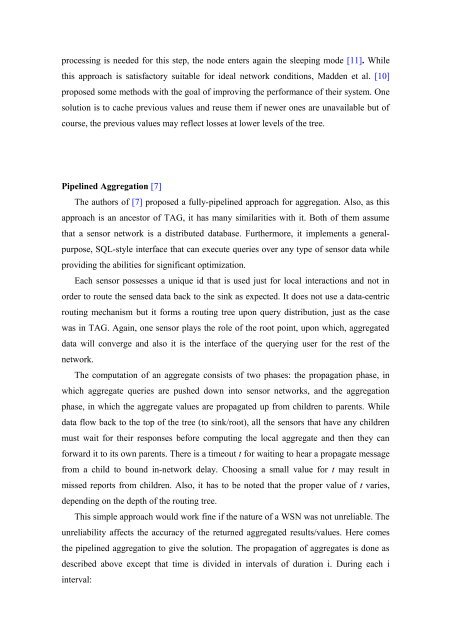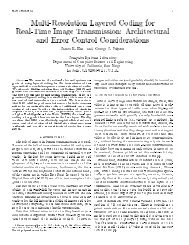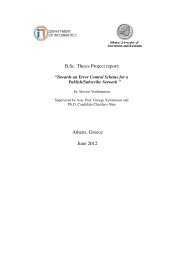In Network Processing and Data Aggregation in
In Network Processing and Data Aggregation in
In Network Processing and Data Aggregation in
Create successful ePaper yourself
Turn your PDF publications into a flip-book with our unique Google optimized e-Paper software.
process<strong>in</strong>g is needed for this step, the node enters aga<strong>in</strong> the sleep<strong>in</strong>g mode [11]. Whilethis approach is satisfactory suitable for ideal network conditions, Madden et al. [10]proposed some methods with the goal of improv<strong>in</strong>g the performance of their system. Onesolution is to cache previous values <strong>and</strong> reuse them if newer ones are unavailable but ofcourse, the previous values may reflect losses at lower levels of the tree.Pipel<strong>in</strong>ed <strong>Aggregation</strong> [7]The authors of [7] proposed a fully-pipel<strong>in</strong>ed approach for aggregation. Also, as thisapproach is an ancestor of TAG, it has many similarities with it. Both of them assumethat a sensor network is a distributed database. Furthermore, it implements a generalpurpose,SQL-style <strong>in</strong>terface that can execute queries over any type of sensor data whileprovid<strong>in</strong>g the abilities for significant optimization.Each sensor possesses a unique id that is used just for local <strong>in</strong>teractions <strong>and</strong> not <strong>in</strong>order to route the sensed data back to the s<strong>in</strong>k as expected. It does not use a data-centricrout<strong>in</strong>g mechanism but it forms a rout<strong>in</strong>g tree upon query distribution, just as the casewas <strong>in</strong> TAG. Aga<strong>in</strong>, one sensor plays the role of the root po<strong>in</strong>t, upon which, aggregateddata will converge <strong>and</strong> also it is the <strong>in</strong>terface of the query<strong>in</strong>g user for the rest of thenetwork.The computation of an aggregate consists of two phases: the propagation phase, <strong>in</strong>which aggregate queries are pushed down <strong>in</strong>to sensor networks, <strong>and</strong> the aggregationphase, <strong>in</strong> which the aggregate values are propagated up from children to parents. Whiledata flow back to the top of the tree (to s<strong>in</strong>k/root), all the sensors that have any childrenmust wait for their responses before comput<strong>in</strong>g the local aggregate <strong>and</strong> then they canforward it to its own parents. There is a timeout t for wait<strong>in</strong>g to hear a propagate messagefrom a child to bound <strong>in</strong>-network delay. Choos<strong>in</strong>g a small value for t may result <strong>in</strong>missed reports from children. Also, it has to be noted that the proper value of t varies,depend<strong>in</strong>g on the depth of the rout<strong>in</strong>g tree.This simple approach would work f<strong>in</strong>e if the nature of a WSN was not unreliable. Theunreliability affects the accuracy of the returned aggregated results/values. Here comesthe pipel<strong>in</strong>ed aggregation to give the solution. The propagation of aggregates is done asdescribed above except that time is divided <strong>in</strong> <strong>in</strong>tervals of duration i. Dur<strong>in</strong>g each i<strong>in</strong>terval:








